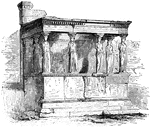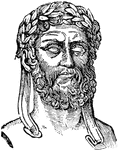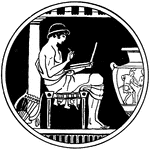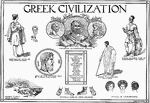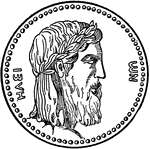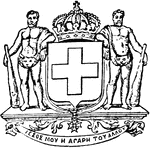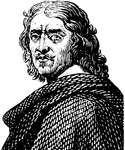
Miltiades
Celebrated general of Athens, born in the latter part of the 6th century B.C. His skill and bravery…
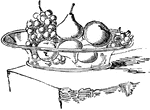
Still Life Painting from Pompeii
"Painting of still life. On a wall of a house at Pompeii." —D'Anvers, 1895
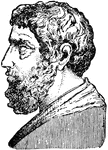
Solon
The great legislator and one of the seven wise men of Greece, born in Athens in 638; died in 558 B.C.…

Thucydides
An eminent historian, born in Athens, Greece, about 471; died about 400 B.C. He was a son of Olorus,…

Lyre
A stringed musical instrument well known for its use in Classical Antiquity. The recitations of the…
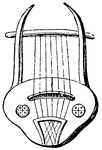
Lyre
A stringed instrument well known for its use in Classical Antiquity. It was used mainly by the Ancient…
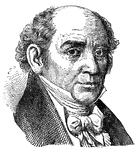
Muzio Clementi
A classical composer, and acknowledged as the first to write specifically for the piano.

Parthenon
The Parthenon is the best-known surviving building of Ancient Greece and is regarded as one of the world's…
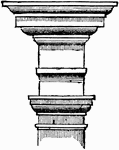
Tuscan Order
A stocky simplified variant of the Doric order that was introducted into the canon of classical architecture…
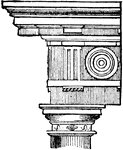
Doric Order
One of the three orders or organizational systems of Ancient Greek or classical architecture.
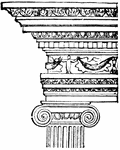
Ionic Order
One of the three orders of classical architecture. It originated in the mid-6th century BC.

Corinthian Order
One of the three orders of classical architecture. It was said to have been invented by an architect,…

Composite Order
A mised order, combining the volutes of the Ionic order with the leaves of the Corinthian order.
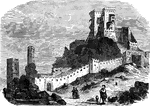
Thebes
The principal city of Baeotia, in ancient Greece, was situated in the south part of the country, onm…

Grotesque
"A style of classical ornament, so called, in the 13th century from its having been rediscovered in…

Hygieia
"In the classical mythology, the goddess of Health- the daughter of Aesculapius. She was worshipped…

Greek Coin
"In the reign of Philip of Macedon, the coinage of Greece had attained its full development, having…
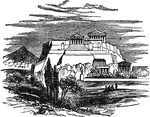
Acropolis
"Acropolis, 'the highest point of the city.' Many of the important cities of Greece and Asia Minor were…

Crown
"Crowns were originally garlands of leaves; and in this form they have probably been used as an ornament…
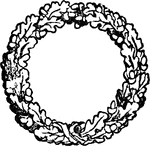
Crown
"Crowns were originally garlands of leaves; and in this form they have probably been used as an ornament…

Obolus
"A small coin of ancient Greece, in later times of silver, the sixth part of an Attic drachma, equal…
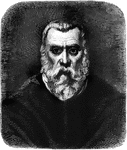
Tintoretto
This portrait is of the great artist, Tintoretto. He was a Greek painter who included external imagry…

Agricultural and Mechanical College of Texas
The basis for funding for the college was established by the Morrill Act, passed by the US Congress…

Bias
Bias, one of the seven sages of Greece; a native of Priene, an Ionia; celebrated for his practical knowledge…
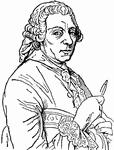
Francois Boucher
(1703-1770) French painter and a proponent of Rococo taste, known for idyllic and voluptuous paintings…

Ptolemy in Profile
He was a mathematician, geographer, astronomer, and astrologer. "The name of a line Graeco-Egyptain…
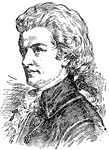
Wolfgang Amadeus Mozart
(1756-1791) German composer of the Classical era. Some of his most famous works are The Marriage of…

Ludwig von Beethoven
(1770-1827) German composer whose most famous works are his Fifth and Ninth symphonies and Moonlight…
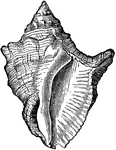
Purpura Consul.
"The Purpuras have a classical name and history, having furnished the Greeks and Romans with the brilliant…

Buccinum Senticosum (Linnaeus)
"The Purpuras have a classical name and history, having furnished the Greeks and Romans with the brilliant…
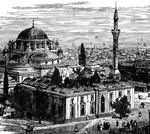
The City of Constantinople (Byzantium)
Byzantine Constantinople had been the capital of a Christian empire, see Christendom, successor to ancient…

Plato
Plato was a Classical Greek philosopher, who, together with his mentor, Socrates, and his student, Aristotle,…

Theodor Mommsen
Christian Matthias Theodor Mommsen (30 November 1817 – 1 November 1903) was a German classical scholar,…

Parthenon
The Parthenon is a temple of the Greek goddess Athena, built in the 5th century BC on the Athenian Acropolis.…
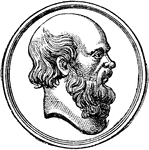
Socrates
An illustration of Socrates, a Classical Greek philosopher. Credited as one of the founders of Western…

Plato
An illustration of Plato, a Classical Greek philosopher, who, together with his mentor, Socrates, and…
